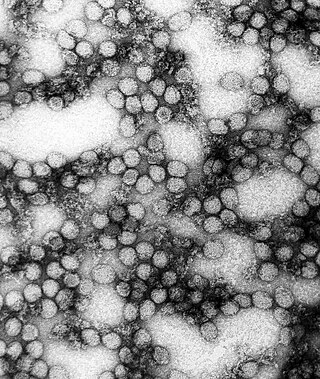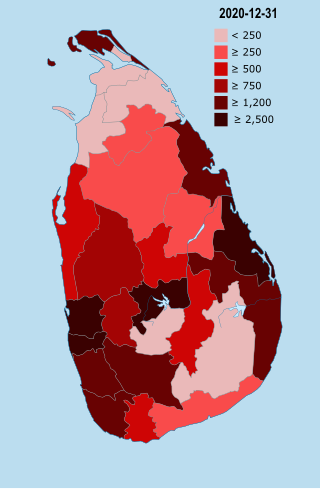| 2011 Dengue Outbreak in Pakistan | |
|---|---|
| Disease | Dengue fever |
| Location | Punjab, Pakistan |
| Date | 2011 |
| Confirmed cases | 14,000+ |
Deaths | 300+ |
Dengue fever is an important infectious disease in Pakistan with increasingly frequent epidemics. [1] Despite the efforts of the Government of Pakistan, especially in Punjab, the high cost of prevention has limited the ability of Pakistan to control epidemics. [2] In Pakistan, in the summer of 2011, more than 300 people died of Dengue fever. The prevalence of the disease was over 14,000. The outbreaks occurred mostly in the Lahore area, Punjab, Pakistan.
In November 2010, more than 21,204 people were diagnosed with dengue fever. [3] Those infected were mainly from Punjab, Pakistan. Patients were admitted to dedicated wards in government hospitals. The severity of the epidemic was greatest in Lahore. [4]
The secretary of the Punjab Mineral Development Corporation, Ataullah Siddiqui and Ghiasuddin, a member of the Punjab Public Service Commission died as a result of the dengue fever. [5] [6] [7] On 30 September 2011, the Punjab MPA Mumtaz Jajja also died of dengue fever. [8] Eight Chinese engineers were taken ill. [9] [10]
A special tribunal for Dengue fever was empanelled. The chairman of the Dengue Emergency Response Committee was Khawaja Saad Rafique. The Government of Pakistan and the provincial Government of Punjab (Pakistan) took preventive measures to reduce the spread of the disease. A hotline called the "Punjab Health Line Project For Dengue" was opened to facilitate knowledge of the signs and symptoms of dengue fever, provide help people affected and identify areas where the epidemic may have spread. Teams of workers fumigated areas, particularly educational institutions and rural areas where the Aedes mosquito was present. In early September 2011, the Government of Punjab (Pakistan) ordered the schools, colleges and universities in Punjab, Pakistan to close for 10 days for intensive fogging to eliminate the vector mosquitoes. [11] [12] [13] [14] Article 144 was implemented in Lahore city for the prevention of dengue fever. After an appeal by the Government of Punjab (Pakistan), private hospitals agreed to provide free treatment to dengue patients. [15] During dengue fever epidemics, the Pakistan army created camps in Lahore city. The Pakistan Air Force has also assisted the government. [16] [17] The Punjab government worked to increase public awareness. [18] Local authorities in Hyderabad held a seminar. [19] Other programs were held in educational facilities. A 24-hour government sponsored online service, the "Punjab Health Line Project For Dengue" provided information about the disease and its prevention.[ citation needed ]
In 2011, the Government of Sri Lanka gave medicines and staff to Punjab. [20] [21] A group of 12 doctors from Sri Lanka came to Lahore to assist. [22] [23] [24] The Indonesian government dispatched a medical team of twenty to assist the Pakistani authorities. [25] The World Health Organization provided technical guidance along with support for provincial and territorial dengue monitoring and coordination committees. [26]

Yellow fever is a viral disease of typically short duration. In most cases, symptoms include fever, chills, loss of appetite, nausea, muscle pains—particularly in the back—and headaches. Symptoms typically improve within five days. In about 15% of people, within a day of improving the fever comes back, abdominal pain occurs, and liver damage begins causing yellow skin. If this occurs, the risk of bleeding and kidney problems is increased.
Dengue fever is a mosquito-borne tropical disease caused by the dengue virus. It is frequently asymptomatic; if symptoms appear they typically begin 3 to 14 days after infection. These may include a high fever, headache, vomiting, muscle and joint pains, and a characteristic skin itching and skin rash. Recovery generally takes two to seven days. In a small proportion of cases, the disease develops into severedengue with bleeding, low levels of blood platelets, blood plasma leakage, and dangerously low blood pressure.

Arbovirus is an informal name for any virus that is transmitted by arthropod vectors. The term arbovirus is a portmanteau word. Tibovirus is sometimes used to more specifically describe viruses transmitted by ticks, a superorder within the arthropods. Arboviruses can affect both animals and plants. In humans, symptoms of arbovirus infection generally occur 3–15 days after exposure to the virus and last three or four days. The most common clinical features of infection are fever, headache, and malaise, but encephalitis and viral hemorrhagic fever may also occur.
In the 2005 dengue outbreak in Singapore, a significant rise in the number of dengue fever cases was reported in Singapore, becoming the country's worst health crisis since the 2003 SARS epidemic. In October 2005, there were signs that the dengue fever outbreak had peaked, as the number of weekly cases had declined and the outbreak of this infectious disease declined by the end of 2005.
In the 2006 dengue outbreak in India, cases of dengue fever were reported first from New Delhi in early September and by the end of September other states also started to report deaths. At least 3613 confirmed cases of dengue fever were reported and over 50 people died in the outbreak.
The 2006 dengue outbreak in Pakistan was at the time the worst on record. There were 1931 lab-confirmed cases, and 41 confirmed deaths, according to the World Health Organization Regional Office for the Eastern Mediterranean. Other sources report a death toll of 52.

Faisal Masud was a renowned Pakistani endocrinologist.

Pakistan is the fifth most populous country in the world with population approaching 225 million. It is a developing country struggling in many domains due to which the health system has suffered a lot. As a result of that, Pakistan is ranked 122nd out of 190 countries in the World Health Organization performance report.

Pakistan–Sri Lanka relations refer to bilateral relations between Pakistan and Sri Lanka. Both countries are located in South Asia. The earliest proper diplomatic and trade contacts between Pakistan and Sri Lanka date back as early as 1948. In 2013, the then prime minister Nawaz Sharif said that there were strong bonds of friendship between the two countries.

The 2009 Bolivian dengue fever epidemic was an epidemic of dengue fever which struck Bolivia in early 2009, escalating into a national emergency by February. The BBC described it as the worst outbreak of dengue fever in the country's history. At least 18 people died and 31,000 were infected by the mosquito-transmitted arbovirus.
The 2009 attack on the Sri Lanka national cricket team occurred on 3 March 2009, when a bus carrying Sri Lankan cricketers, part of a larger convoy, was fired upon by 12 gunmen near Gaddafi Stadium in Lahore, Pakistan. The cricketers were on their way to play the third day of the second Test against the Pakistani cricket team. Six members of the Sri Lanka national cricket team were wounded and six Pakistani policemen and two civilians were killed.
The International Vaccine Institute (IVI) is an independent, nonprofit, international organization founded on the belief that the health of children in developing countries can be dramatically improved by the use of new and improved vaccines. Working in collaboration with the international scientific community, public health organizations, governments, and industry, IVI is involved in all areas of the vaccine spectrum – from new vaccine design in the laboratory to vaccine development and evaluation in the field to facilitating sustainable introduction of vaccines in countries where they are most needed.

Umar Saif is a Pakistani computer scientist and academic. He is the founder and CEO of aiSight.ai, Chief Digital Officer of the Jang Group and CEO of Khudi Ventures. He is currently serving as interim Federal Minister For Science and Technology, as well as Minister of IT. He is also serving as an advisor to the United Nations Development Programme in Pakistan.

As of 2010, dengue fever is believed to infect 50 to 100 million people worldwide a year with 1/2 million life-threatening infections. It dramatically increased in frequency between 1960 and 2010, by 30 fold. This increase is believed to be due to a combination of urbanization, population growth, increased international travel, and global warming. The geographical distribution is around the equator with 70% of the total 2.5 billion people living in endemic areas from Asia and the Pacific. Many of the infected people during outbreaks are not virally tested, therefore their infections may also be due to chikungunya, a coinfection of both, or even other similar viruses.
In the 2013 dengue outbreak in Singapore, a significant rise in the number of dengue fever cases was reported in Singapore. The outbreak began in January, with the number of infections beginning to surge in April, before eventually reaching a peak of 842 dengue cases in the week of 16–22 June 2013. This figure was far beyond the highest number of cases per week in the previous three years. Although there were concerns that the rate of infection could exceed 1,000 per week, these fears did not materialize.
In the 2017 dengue outbreak in Peshawar, Pakistan, hundreds of incidents of dengue fever were reported in Peshawar in mid-2017. Initially, according to the health department of Khyber Pakhtunkhwa, 4,320 suspected cases were received by Khyber Teaching Hospital Peshawar and 831 were positive. About a dozen people died of dengue, starting in July. Punjab healthcare experts and Peshawar experts worked together to control the dengue epidemic, using health workers going door-to-door to educate residents, as well as fumigation of the city to suppress mosquito populations.

The 2019–2020 dengue fever epidemic was an epidemic of the infectious disease dengue fever in several countries of Southeast Asia, including the Philippines, Malaysia, Vietnam, and Bangladesh, Pakistan, India, Thailand, Singapore, and Laos. The spread of the disease was exacerbated by falling vaccination levels in certain areas, and by a growing population of mosquitoes, which are the primary carriers of the disease, and which are able to reproduce in larger numbers where humans have littered the environment with plastic containers, which provide an ideal breeding ground for mosquitoes. Affected countries have sought to control the epidemic through increased vaccination efforts, and through efforts to control the mosquito population.

The dengue pandemic in Sri Lanka is part of the tropical disease dengue fever pandemic. Dengue fever is caused by Dengue virus, first recorded in the 1960s. It is not a native disease in this island. Present-day dengue has become a major public health problem. Aedes aegypti and Aedes albopictus are both mosquito species native to Sri Lanka. However, the disease did not emerge until the early 1960s. Dengue was first serologically confirmed in the country in 1962. A Chikungunya outbreak followed in 1965. In the early 1970s two type of dengue dominated in Sri Lanka: DENV-1 type1 and DENV-2 type 2. A total of 51 cases and 15 deaths were reported in 1965–1968. From 1989 onward, dengue fever has become endemic in Sri Lanka.

In the 2017 dengue epidemic in Sri Lanka, a rise in the number of dengue fever cases was reported on the island country of Sri Lanka. The peak of the outbreak was in the mid-year monsoon rain season, when there was record of over 40,000 cases in July. This figure was far beyond the historical highest number of cases per month in Sri Lanka. Year end total dengue cases rose to 186,101.